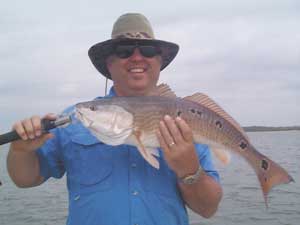
Sheepshead, spadefish, flounder, redfish, trout, and king mackerel are fun to catch and tasty to eat. Deciding what to fish for depends on how rough is the ocean, what are the tides, time of year, and most of all what an angler wants to chase.
Bringing tackle that produces the best results during a particular day for a targeted species can be challenging. Previous experiences usually dictate what presentation of lures/baits will produce the most strikes, but nothing guarantees results during each new day of fishing.
Each day is different and some days will have better conditions for spadefishing at the reef; other times are better suited for flounder or red fish at the bay. Moreover, spottails may bite soft plastics better than natural baits or they may prefer an incoming tide versus the outgoing tide that particular day.
Usually, there’s not a boat or perfect set of tackle and gear suited for every scenario — or even a single species. However, tackle and gear diversity on board a boat should leave anglers a winner in going for something. So a compromise between tackle diversity and being cluttered is the way to go.
Fish tend to prefer a common presentation and are susceptible to patterning, but as conditions change the fisherman must also change.
Good fishermen who invest many hours on the water will figure out the best fishing methods for given conditions, but nothing can take the place of time on the water. However, most anglers don’t get the opportunity to spend extreme amounts of time on the water each year to understand thoroughly how to outsmart fish under differing conditions.
Take it from Fred Roark of Sweet Tea Charters in Georgetown.
“The secret to catching many fish is to spend the time on the water fishing,” he said. “It’s as simple as that.”
The majority of the fisherman in South Carolina and elsewhere go fishing when the opportunity arises or when they can go. The recreational fisherman needs to learn to diversity and be prepared on the water for different conditions.
Alternative presentations, tactics, and techniques must be incorporated to figure out what, when, where and how. Here’s a few tips about learning to focus better on the fish you want to catch:
• Try to limit the targeted species to inshore or offshore species, but not both.
• For inshore fishing trips, a combination of spinning and casting rods allow for multiple tackle presentations. Depending on the size of the boat, the number of rods and tackle boxes per person should be maximized to the point before being too cluttered. Using three to five rods per person is usually a good mix.
• Inshore fish usually require more rods and tackle because the water is relatively shallow and it’s more affected by the tides.
• The perfect mixture of rigs includes a combination of soft plastics, hard baits, flashy baits, and natural baits of varying size, color, and presentation ability.
• Rig different lures for different water depths or presentations using each of the rods.
• Cast multiple lures at targets using differing presentations until something works.
• There is no “wonder bait” or “wonder color” that works under all conditions better than any other. Try different combinations until something works.
• Fishing the same location under different tide stages will also surprise anglers.
Many anglers commonly make the mistake of pinpointing a pattern with one fish being caught. Webster defines a pattern as “a consistent, characteristic form, style, or method.”
Note the word “consistent.” One event does not a pattern make.
Try to hypothesize the pattern and test again, but don’t put away the rest of your tackle and rely on a single fish to determine a pattern. It takes more than one.
When bottom fishing, trolling, or float fishing, try different baits, different depths, and other presentations to find out what the fish want that day.
Captain Eric Heiden of Heidenseek Charters at Georgetown fishes for about every fish in the ocean, but specializes in “genuine” red snappers. Before he drops a line in the water, he rigs every angler’s rod and reel on his boat with a different bait combination. Then he drops all of his clients lines in the water at the same time to offer the best presentation possible — and find out which lure/bait the fish want that day.
“You can never make more than one first impression, so let it be your best,” he said.
Whether fishing offshore for blue marlin or inshore for flounder and trout, a diversity of lures and presentations will improve the chances of outsmarting any fish in the ocean. That’s the best way to put fish in the cooler and on the dinner table.




Be the first to comment